
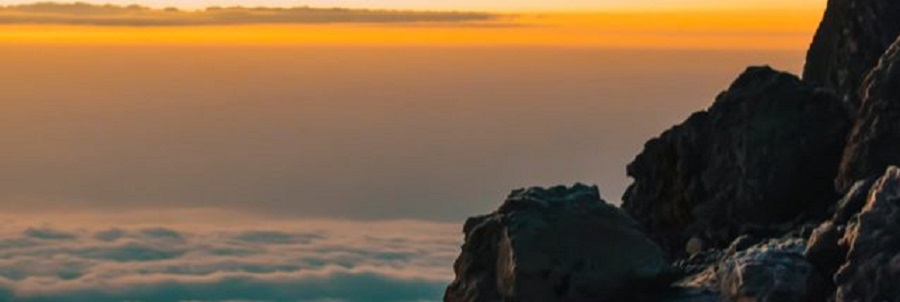
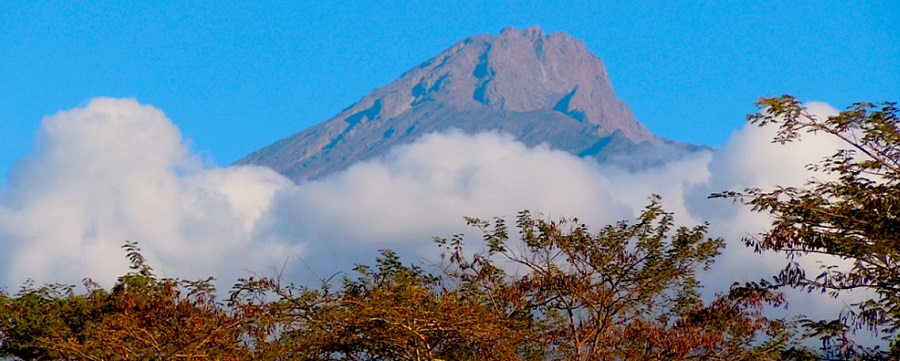
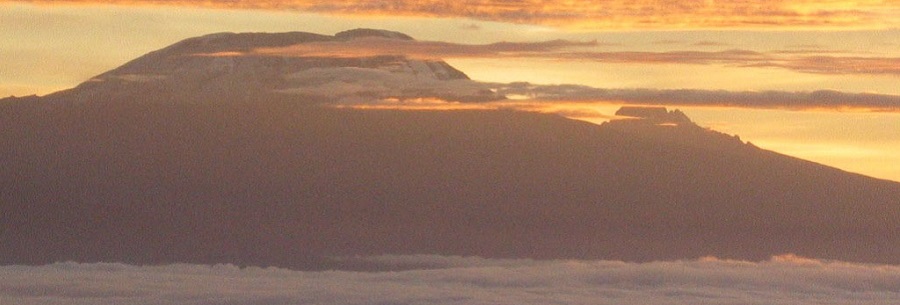
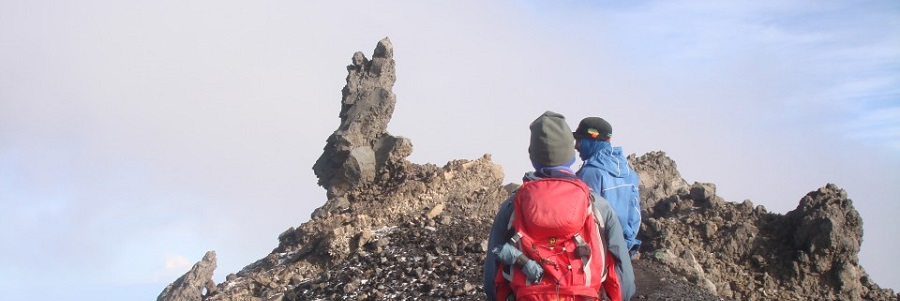
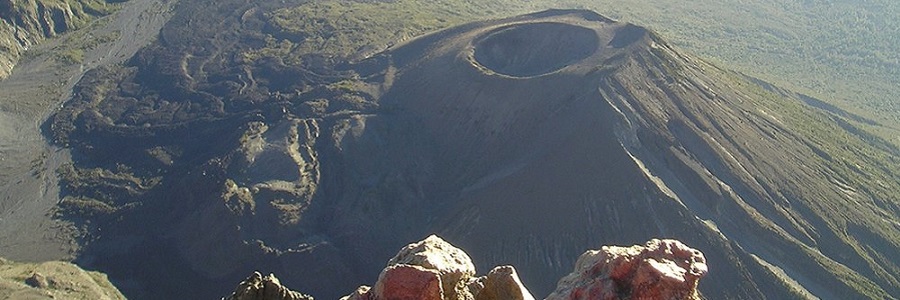
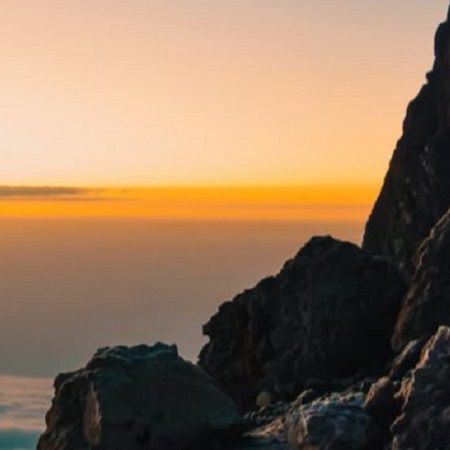
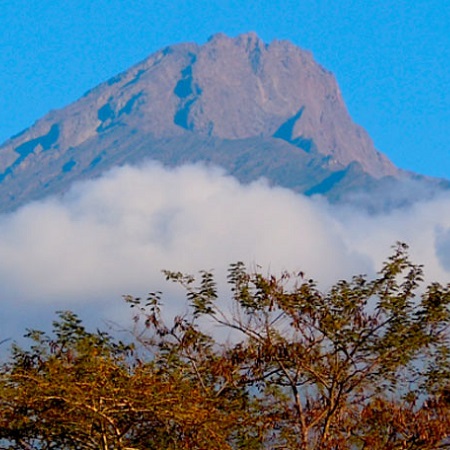
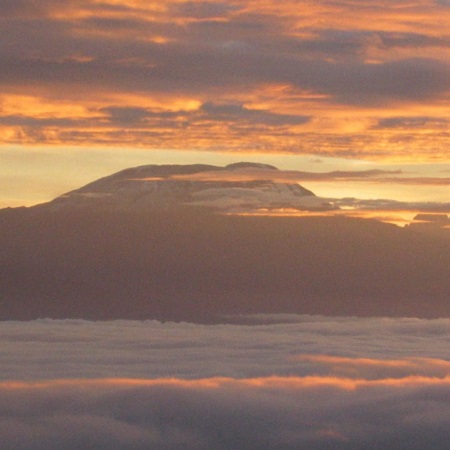
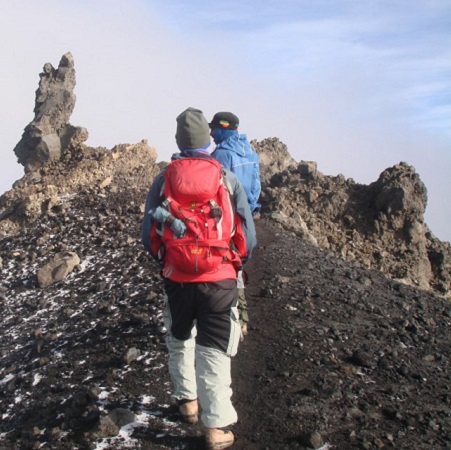
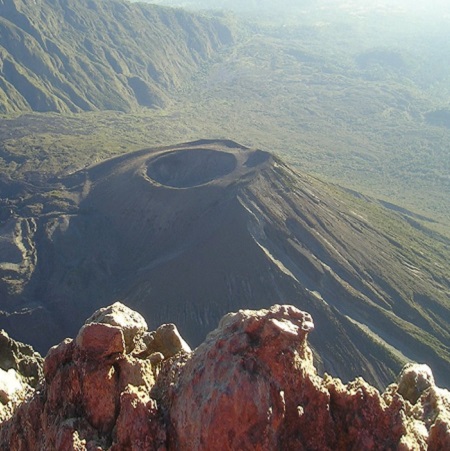
Der Mount Meru ist mit 4566 m der fünfthöchste Berg des afrikanischen Kontinents und der zweithöchste in Tansania. Vor etwa 250 000 Jahren hat eine massive Vulkanexplosion die gesamte Ostflanke des Berges weggeblasen und ihm das charakteristische und unverwechselbare Aussehen verliehen, das er heute hat. Letzter Ausbruch: 1910
Der Mount Meru ist mit 4566 m der fünfthöchste Berg des afrikanischen Kontinents und der zweithöchste in Tansania. Vor etwa 250 000 Jahren hat eine massive Vulkanexplosion die gesamte Ostflanke des Berges weggeblasen und ihm das charakteristische und unverwechselbare Aussehen verliehen, das er heute hat. Der Aufstieg zum Mt. Meru führt durch viele verschiedene Vegetationszonen. Der trockene Wald der unteren Region weicht einem dichten Bergregenwald, der sich dann in ein Buschland verwandelt. Auf dem Gipfel des Berges besteht die Vegetation aus Heide und Moorland und wird schließlich durch die atemberaubenden Baron-Alpenwüsten ersetzt. Wenn sich die Flora ändert, tut dies auch die Tierwelt, die vielfältig und ebenso beeindruckend ist. Während des Aufstiegs werden Sie regelmäßig auf Großwild wie Elefanten und Büffel stoßen, aber Sie können auch auf Leoparden stoßen. Aus diesem Grund ist es obligatorisch, auf Ihrer Tour von einem bewaffneten Park Ranger begleitet zu werden.
Am Morgen werden Sie von Ihrem Hotel abgeholt und nach einer 45-minütigen Fahrt erreichen Sie das Arusha National Park Gate. Am Nationalpark-Tor füllt Ihr Guide die obligatorischen Anmeldeformulare aus. Währenddessen können Sie die Informationstafeln des Nationalparks lesen. Sobald die Formalitäten erledigt sind und sich das aus Trägern aus den umliegenden Dörfern bestehende Wanderteam gebildet hat, werden Sie etwas weiter zum Momella-Tor gefahren. Ein bewaffneter Park Ranger wird Sie begleiten, während Sie Ihre Wanderung beginnen und einen ersten Blick auf die wunderbaren Giraffen und Büffel werfen. Sobald Sie die Büffelherden und Giraffen zurückgelassen haben, betreten Sie den Akazienwald, in dem Sie der Südroute folgen. Nach einem stetigen 2-stündigen Aufstieg erreichen Sie die Maio Falls und einige malerische Wiesen, die ein perfekter Ort für ein Picknick sind. Nach einer Pause sind Sie wieder unterwegs und erreichen bald den bekannten „Arched Fig Tree“. Hier erzählt Ihnen Ihr Park Ranger von der Entstehung dieses Baumes und wie er seine Form erlangt hat und einen Bogen über den Weg bildet. Nach weiteren 1½ - 2 Stunden erreichen Sie die Miriakamba-Hütte. Abendessen und Übernachtung in der Miriakamba-Hütte. Frühstück; Mittagessen; Abendessen
Am Morgen verlassen Sie die Miriakamba-Hütte und folgen einem steilen Pfad mit Holzstufen nach oben. Aufgrund des Höhenunterschieds wird es merklich kühler als am Vortag und aufgrund dessen scheint die Wanderung einfacher zu werden. Die Wolken hängen auch oft im Regenwald und tauchen die üppige Vegetation in eine launische Atmosphäre. Nach ca. 2 Stunden erreichen Sie den Aussichtspunkt „Mgongo wa Tembo“ (Elefantenrücken) auf einer Höhe von 3200 m, wo Sie eine
wohlverdiente Pause genießen können. Nach einer weiteren Wanderung, bei der sich die Vegetation vom Regenwald in ein luftiges Buschland verwandelt, erreichen Sie mittags die Sattelhütte (3550 m) für eine entspannende Mittagspause. Am Nachmittag haben Sie die Möglichkeit, einen Abstecher nach Little Meru (3820 m) zu machen, der ca. 1 - 1 ½ Stunden und von wo aus Sie einen herrlichen Blick auf den Arusha-Nationalpark und den Kilimandscharo (ca. 80 km entfernt) haben. Zurück in der Hütte wartet ein warmes Abendessen auf Sie, bevor Sie das letzte Vorgespräch zur Vorbereitung des Aufstiegs zum nächsten Tag auf den Gipfel führen. Frühstück; Mittagessen; Abendessen
Nach einem frühen Start mit Tee und Keksen fahren Sie um 02:00 Uhr zum Gipfel. Bei Fackelschein folgen Sie dem Weg durch Buschland zum sogenannten Rhino Point (3821 m), wo sich der Weg in eine etwas anspruchsvollere Wanderung mit gelegentlichen leichten Anstiegen verwandelt. Sie folgen dem Nordgrat bis zum Gipfel, auf dem Sie abwechselnd zwischen Lava-Asche und Felsen auf dem Boden laufen. Nach ca. 4 - 5 Stunden haben Sie den Gipfel und die tansanische Flagge im Visier. Vom Gipfel aus können Sie den Sonnenaufgang über dem Kilimandscharo und den fantastischen Blick auf den Krater des Mount Meru mit seinen steilen Seiten und den „Aschenkegel“ in der Mitte genießen. Der Abstieg erfolgt auf demselben Weg zurück zur Sattelhütte (3550 m), wo Sie eine wohlverdiente lange Pause einlegen und sich mit heißer Suppe und Tee erholen können. Nach dem Aktualisieren fahren Sie mit dem Abstieg fort. Am frühen Nachmittag erreichen Sie die Miriakamba-Hütte (2500 m) - müde, aber glücklich. In dieser Hütte können Sie sich entspannen und über die letzte Etappe nachdenken, die Sie abgeschlossen haben. Abendessen und Übernachtung in der Miriakamba-Hütte (2500 m). Frühstück; Mittagessen; Abendessen
Nach dem Frühstück folgen Sie einer 2 bis 3-stündigen Wanderung über die sogenannte Nordroute zurück zum Momella-Tor. Der Abstieg ist kürzer als der Aufstieg, aber es besteht immer noch die Möglichkeit, Elefanten, Büffel, Giraffen sowie die schwarz-weißen Columbus-Affen zu sehen. Am Tor verabschieden Sie sich von Ihrer Wandermannschaft und Ihr Fahrer bringt Sie zurück nach Arusha. Frühstück
Die Gipfelbühne enthält einige einfache, aber ungesicherte Kletterpassagen. Ein guter Kopf für die Höhe und ein sicherer Stand sind absolut notwendig. Bei widrigen Wetterbedingungen (starker Regen, eisige Felsen und Wege oder dichter Nebel) kann der Park Ranger den Aufstieg zum Gipfel abbrechen. In der Regenzeit (April und Mai) empfehlen wir keine Anstiege.
• Gebühren für das Nationalpark-Tor
• Transport von Arusha zum Trail Head und zurück
• Hüttengebühren
• Zertifizierte, erfahrene, englischsprachige Guides
• National Park Ranger (vom Arusha National Park gefordert)
• Alle Mahlzeiten am Berg
• Tipps für Guides, Ranger und Träger
• Fügen Sie 250 USD / Person / Tag für einen zusätzlichen Tag auf dem Berg hinzu
• Schlafsack und persönliche Gegenstände
HERZLICH WILLKOMMEN
With the above said, Meru is of course a great way to prepare for Kilimanjaro as it gives you a little taster as to what to expect on the bigger mountain.
The most important thing Meru prepares you for is altitude acclimatization. Do not underestimate Meru as it is a challenging climb! It is certainly high enough to bring on altitude sickness. At a height of 4,566m, Meru is a tall mountain in its own right and forces your body to make changes to adapt to the altitude. Please click here for a full guide on how to deal with acclimatization.
Not only this, but like Kilimanjaro, you travel in a group with porters carrying your gear and move up through several vegetation zones in 1 day. Similar to Kilimanjaro, you trek the summit at night, reaching the peak just before sunrise. You then descend an amazing 2000m on the same day! All these similarities allow your body (and your mind) to prepare for Kilimanjaro.
Unlike Kilimanjaro, there is only one official route to the summit of Meru – the ‘Momella route’. Although there is a 3-day (8.7 mile) option, we discuss the longer, more popular 4-day (11.8 mile) climb. Generally, we recommend climbing between June and February with December to February being the best months for clear views of Kilimanjaro.
Elevation – 1500m to 2500m. Time: 3 – 4 hours. Habitat – Montane Forest.
Most tour operators will collect you from your hotel in the morning and take you to Arusha National Park. Once at headquarters your papers, visa and permits will all be checked and made ready for departure. From head office you will be taken by van to the Momella Park Gate from where your trek will begin. The trail starts by winding its way through montane forest where you will see waterfalls, wildlife and some pretty oddly formed trees! Remember, an armed national park ranger will accompany you on your route. The first day of trekking will end when you reach Miriakamba hut. Unlike Kilimanjaro, accommodation on Meru consists of huts dotted up the mountain.
Elevation – 2500m to 3550m. Time: 3 – 4 hours. Habitat – Moorland
On the second day you will ascend over a 1000m to Saddle Hut at 3,550m. The air will get cooler and you may feel slightly more out of breath as the air gets thinner. Saddle Hut will be reached by early afternoon which will give you time to visit ‘Little Meru’ at 3,820m. Not only will you get great views of Kilimanjaro, but it’s a good way for your body to acclimatize to the altitude.
Elevation – 3550m to 4256m to 2500m, Time: 8 – 10 hours. Habitat – Semi Desert, Alpine Desert, Montane Forest.
Your summit ascent begins in the middle of the night at 2am. Following a quick midnight snack you trek to 3,820m where you find Rhino Point. After a quick break you then climb a further 4-5 hours where, towards the top, you will traverse the exhilarating and very narrow crater rim path! This is all rewarded as you hit the summit just before sunrise. The 360 degree views are spectacular, especially the sun rising over Kilimanjaro! Before your descent you can explore Meru’s ash cone within the crater.
Elevation – 2500m to 1500m. Time: 2 – 3 hours. Habitat – Montane Forest
The fourth day is an easy going few hours down through the montane forest area where you will once again see wildlife and beautiful habitat. Seeing the forest from above is a completely different experience to seeing it on the way up – look out for birds!
Still haven’t booked your Mount Meru trek yet? Click here for our personal recommendations.
Click here for our complete kit list recommendations.
If you still have any questions then please feel free to leave a comment in the section below and we will get back to you as soon as possible.
As the Web's #1 information resource on climbing Kilimanjaro, we recently put together this page to help prospective climbers, like yourself, find the cause closest to your heart to support.
Please Note: We are not a tour operator and do not run charity Kilimanjaro climbs. Please contact the charities directly for further information.
Contact us to be included on this Climb Kilimanjaro for Charity page.
Magnetized by Mt Kilimanjaro, the hikers often overlook Mt Meru, the second highest peak of Tanzania. Towering over Arusha National Park, Mount Meru offers both an excellent warm-up exercise for Kilimanjaro, in addition to being a stunning trekking experience in the wild by its own right.
Mount Meru trekking is a real adventure. The slopes of this dormant (yet active - the last eruption was in 1910) volcano offer fascinating panoramic vistas and bustling wildlife around.
This volcano was “born” around 500,000 years ago, and it’s very first eruption virtually exploded its eastern side, creating its, peculiar appearance. In addition to that, Mt Meru has one of the deepest craters - over 1,500 meters!
There are several reasons to include Mount Meru into your Tanzania adventures list. Regrettably, this volcano is often out shadowed by Kilimanjaro - located in the immediate vicinity, it attracts more international hikers, thus making it a secondary hiking destination or a warm-up exercise. The majority of hikers, however, ignore it altogether.
We at Africa Natural Tours firmly believe that Mt Meru hiking is a great adventure by itself because of these reasons:
Reason 1 - Stunning scenery
Mount Meru features incredibly captivating scenic vistas. The trek to Socialist Peak (4566 m/14,980 f), traverses several climatic zones, offering diverse landscapes and unparalleled scenes for wildlife photography.
The views from the summit area of Mt Meru are truly rewarding - valleys, forests and meadows, all buried in lush verdure, and magnetizing view of the Kilimanjaro peak looming on a horizon will surprise even the most seasoned travelers.
Nestled in Arusha National Park, Mount Meru is one of the few mountains of the world still densely inhabited by the wildlife, which freely roam on its slopes. The hikers are likely to experience multiple encounters with different animals, including buffaloes, antelopes, monkeys, giraffes and, with some luck in your pocket, even elephants.
Meru is not yet popular among hikers. During the high season, on the popular routes of Kilimanjaro (Marangu and Machame) there is a chance of “traffic jams”, something that you will never experience on the trails of Meru. For those who are seeking reclusive, tranquil hiking in the wild, Meru is a great choice.
EXCELLENT PREPARATION FOR KILIMANJARO Climbing Mount Meru is by far the most proven way to gain acclimatization for your Kilimanjaro adventure. As we explained in our article about the importance of high altitude acclimatization, it is the adaptation of your body to the heights (not your physical strength and stamina) that is critical for the Kilimanjaro success. Practically, the longer you stay at high altitudes, the better your body adapts. Thus, hiking Meru before Kilimanjaro is a good extra acclimatization boost for you, hugely elevating your Uhuru chances! In addition, Mt Meru trekking gives good insights into what it takes to be a member of a true mountain expedition. A minor of version of Kilimanjaro, it gives a glimpse into the “main mount” challenge, showing you what the future adventure will be like.
In contrast to other hiking adventures, Mt Meru climb is quite an affordable activity. Because no tents are necessary (overnight stays on Mt Meru are in huts), the number of crew is small, reducing the travel costs. Therefore, for those with shrinking budgets, Meru can become a good and affordable alternative.
The wildlife of Tanzania is what attracts most of the visitors to the country. Tanzania has been voted the best destination for wildlife viewing several years in a row.
At the same time, flying over half of the world surely justifies having more diverse experiences. Thus, pairing your safari tour with a Meru climb may be an excellent idea to get the best of Tanzania.
The key features of Mt Meru expedition:
You do not need special alpine skills or experience to take part. Together with Kilimanjaro, Mount Meru is a “hiking”, not climbing “mountain”. Neither ropes, nor ice axes or helmets are necessary - the trekkers reach the Socialist Peak (4,562 m/14,967 f) on foot, and for the majority of them, Mt Meru is the first mountaineering experience.
Ordinary fitness level is ok. Meru hiking does not require anything special - as long as you can comfortably walk up to 10 km/6 miles per day, you can do it. Trekking level there is moderate.
Acclimatization to altitude is important! Do not take it lightly - the altitude of Mt Meru is serious enough to be the cause of altitude sickness. Follow these fundamental rules acclimatization:
The combination of these simple principles will make your Meru climb enjoyable, safe and successful.
The crew will take care of everything. Under the TANAPA (Tanzania National Parks Authority), a qualified guide should accompany the hikers. The team of porters and cooks are responsible for carrying your luggage, camp organization, food preparation, etc.
CLIMBING STANDARDS AT Africa Natural Tours we believe that it is the crew that makes your adventure a lifetime experience. All our guides and porters are hand-picked, individually trained professionals. The guides have Wilderness First Responder/Wilderness First Aid certifications. They know how to act in times of emergency and how to make your experience with Africa Natural Tours a lifetime adventure.
Under the local customs, in order to promote employment, half of the porters crew should be hired from the Meru tribe, which live in the foothills of Mount Meru.
Overnight stays on Mount Meru are in huts only. In contrast to Kilimanjaro, where tented camping options are available on all routes but Marangu, on Mount Meru one should be ready to stay in huts only.
An armed ranger will be accompanying your party up to the summit camp. In order to make your stay in the wild safe and protect the animals from poachers, an armed ranger will be hiking with you up to Saddle Hut Camp (see itinerary below).
There is only one route leading to Socialist Peak - “Momella”. Three- and four-day hiking are available
3-DAY VS. 4-DAY HIKE - HOW TO CHOOSE? If the schedule allows and you have not gained acclimatization on other mountains before (meaning that you have successfully climbed anything above 4,000m/13,123f and did not get affected by altitude sickness), we always recommend choosing a longer option. The more time you spend on Mount Meru - the more effectively your body adapts to the altitude, making the whole experience less stressful for it.
The Momella route approaches Mount Meru from the eastern face, moving up through the northern ridge to the peak.
The total trek distance is 45 km/27 miles.
From Wikipedia, the free encyclopedia
Jump to navigation Jump to search
For the Indian peak, see Meru Peak . For the Tanzanian mountain, see Mount Meru (Tanzania).
For the mountain in the Meru region of Kenya, see Mount Kenya. For Mount Meru in Buddhism, see Mount Meru (Buddhism).
Bhutanese thangka of Mount Meru and the Buddhist universe , 19th century, Trongsa Dzong , Trongsa , Bhutan
The MahaBodhi Temple, a famous Buddhist temple at Bodhgaya, India representing the Mt. Meru
Mount Meru (Sanskrit/Pali: मेरु), also recognized as Sumeru, Sineru or Mahāmeru, is the sacred five-peaked mountain of Hindu, Jain, and Buddhist cosmology and is considered to be the center of all the physical, metaphysical and spiritual universes.[1]
Many famous Buddhist temples and similarly Jain as well as Hindu temples have been built as symbolic representations of this mountain. The "Sumeru Throne" 須彌座 xūmízuò style base is a common feature of Chinese pagodas. The highest point (the finial bud) on the pyatthat, a Burmese-style multi-tiered roof, represents Mount Meru.
Etymologically, the proper name of the mountain is Meru (Pāli Meru), to which is added the approbatory prefix su-, resulting in the meaning "excellent Meru" or "wonderful Meru".[2] Meru is also the name of the central bead in a mālā.[3]
In other languages, Mount Meru is pronounced:
The dimensions attributed to Mount Meru — which all refer to it as a part of the Cosmic Ocean, along with several other statements that describe it in geographically vague terms (e.g., "the Sun along with all the planets circle the mountain") — make the determination of its location most difficult, according to most scholars.[5][6]
Some researchers identify Mount Meru or Sumeru with the Pamirs, northwest of Kashmir
The Suryasiddhanta mentions that Mt. Meru lies in the middle of the Earth ("bhuva-madhya") in the land of the Jambunad (Jampudvīpa). Narapatijayacharyasvarodaya,[14] a ninth-century text, based on mostly unpublished texts of Yāmal Tantr, mentions:
Main articles: Buddhist cosmology and Mount Meru (Buddhism)
Yuan dynasty 1271–1368) Chinese mandala depicting Mount Meru as an inverted pyramid topped by a lotus.
According to Buddhist cosmology, Mount Meru (or Sumeru) is at the centre of the world,[17] and Jambūdvīpa is south of it. It is 80,000 yojanas wide and 80,000 yojanas high according to the Abhidharmakośabhāṣyam[18][19] and 84,000 yojanas high according to the Long Āgama Sutra.[4] Trāyastriṃśa is on its peak, where Śakra resides. The Sun and the Moon revolve around Mount Meru, and as the Sun passes behind it, it becomes nighttime. The mountain has four faces — each one made of a different material; the northern face is made of gold, the eastern one is made of crystal, the southern one is made of lapis lazuli, and the western one is made of ruby.[17]
In Vajrayāna, maṇḍala offerings often include Mount Meru, as they in part represent the entire universe.[20][21] It is also believed that Mount Meru is the home of the buddha Cakrasaṃvara.[22]
Painting of Mount Meru from Jain cosmology from the Samghayanarayana
Main article: Jain cosmology
According to Jain cosmology, Mount Meru (or Sumeru) is at the centre of the world surrounded by Jambūdvīpa,[24] in form of a circle forming a diameter of 100,000 yojans.[25] There are two sets of sun, moon and stars revolving around Mount Meru; while one set works, the other set rests behind Mount Meru.
[26][27][28]
The 24th and last Tirthankara, Lord Mahāvīra, was taken to the summit of Meru by Indra shortly after his birth, after putting his mother Queen Trishala into deep slumber. There, he was bathed and anointed with precious unctions.[29][30] Indra and other Devas celebrated his birth.
This mythical mountain of gods was mentioned in the Tantu Pagelaran, an Old Javanese manuscript written in the 15th-century Majapahit period. The manuscript describes the mythical origin of the island of Java, as well as the legendary movement of portions of Mount Meru to Java. The manuscript explains that Batara Guru (Shiva) ordered the gods Brahma and Vishnu to fill Java with human beings. However, at that time, Java island was floating freely on the ocean, always tumbling and shaking. To stop the island's movement, the gods decided to nail it to the Earth by moving the part of Mahameru in Jambudvipa (India) and attaching it to Java.[31] The resulting mountain is Mount Semeru, the tallest mountain on Java.
Mount Semeru, a large active volcano on Java, is named after the mount.
When you're talking about Meru, you’re either talking about a mountain in Africa or in Nepal. Talking about Africa then Mount Meru is a dormant stratovolcano located 70 kilometers west of Mount Kilimanjaro in the country of Tanzania. At a height of 4,562.13 meters (14,968 ft), it is visible from Mount Kilimanjaro on a clear day and is the fifth-highest mountain in Africa.
If you're talking about the Nepalese Himalaya's then Meru is the most difficult mountain in the world to climb. No one has successfully made the ascent up its Shark's Fin, a sheer wall of rock ascending 20,000 feet. Bookatrekking.com is merely about trekking and hiking accessible mountains, so let's talk about Mount Meru in Tanzania!
"I love Mount Meru. It's much easier to climb the mountain, the huts are well equipped and you can do it in a long weekend if you want to." When you are climbing Mount Meru, you are likely to see a lot of wildlife. "That's right," says. Mount Meru is situated in Arusha National Park and that comes with a lot of wildlife. That is why we would never send you on to the mountain without an armed ranger. Arusha National Park may not be the place to spot all of the Big Five, but you will see elephants, giraffe, zebra and lots of buffalo. Even at an altitude of 3500 meters, you can still see buffalo."
Although leopard and cheetah are rare in Arusha National Park, there is a chance to spot those as well. You could also come across a hippo. The armed ranger is joining you on the climb to make sure that you will not be negatively surprised by any of the wildlife in the park and on the mountain. Although you can also see wildlife on Mount Kenya, it is pretty unique to be climbing a mountain in the middle of all the wildlife. This is one of the reasons why climbers like Mount Meru so much more than Kilimanjaro. In Kilimanjaro National Park the chances of seeing a lot of wildlife are slim.
Socialist Peak on Mount Meru is 4,562 m high and Uhuru Peak on Mount Kilimanjaro is 5,895 m high. The mountains are just 70 kilometers apart, so you can easily combine them. Climbing Mount Meru will help you with your acclimatization. "It is a fantastic mountain to get used to climbing to high altitude in Tanzania. If you have the time, we can definitely recommend climbing Mount Meru before your attempt to climb Mount Kilimanjaro. And why not? Within two weeks you can climb the highest and the fifth highest mountain in the world and you don't even need to travel extra for it." More and more people are making the choice to combine Mount Meru with the Roof of Africa. It is not only a great acclimatization for climbing Kilimanjaro. It also gives you some time to get used to climbing in Tanzania.
"People tend to rush to Mount Kilimanjaro. They arrive the day before their climb and already leave the country the day after. There is more to do and see in and around Moshi. Mount Meru allows you to see Arusha National Park, soak up some real African spirit by seeing wildlife and making more of your holiday.
You can climb Mount Meru all year round. The huts are comfortable, you won't need to camp in the rain and it is not as cold as for example on Kilimanjaro. Of course, there's a best season for everything. The best season for your Mount Meru climb is between June and February with December to February being the best months for the best views of Kilimanjaro.
When you are preparing for your Mount Meru climb it is important to have the right bags, the right clothes, the right shoes or boots, the right gloves, the right headwear, the right sleeping bag, and all the extras. If you are spending some extra time in Moshi or Arusha, then you can buy a lot of gear there, but don’t push your luck. Don’t overpack, don’t bring jewelry, don’t bring a classic towel, jeans, or cotton t-shirts. For Mount Meru, you can stick to the same packing list as for when climbing Kilimanjaro.
"Accommodation on Mount Meru is really comfortable. It is way more comfortable than the huts on the Marangu Route on Kilimanjaro. There is electricity to charge your phone and camera, there are decent latrines. Trekking on Mount Meru is really comfortable."
The Miriakamba Huts, where you will stay for the first night are easily reached with 4x4 vehicles. This hut has rooms which can fit 4 people and there are comfortable bunks and well-equipped bathrooms.
You will stay at Saddle Hut the night before your push to Socialist Peak at 3500 meters. These huts are a bit more basic but have all the amenities which you also find at Miriakamba Huts. Even here, you can still encounter buffalo and other game.
Book your climb to the top of Mount Meru with local experts. Find the perfect trek for you here.
Fair enough, Mount Meru isn't Kilimanjaro. But if it wouldn't be standing next to Kilimanjaro, it probably would have gotten a lot more credit than it is getting now. Mount Meru is 4,565m high and the fifth highest peak of Africa. You can climb Mount Meru to warm up for your Kilimanjaro ascent, but don't think that Mount Meru is a walk in the park. You will need decent fitness when you want to do a Mount Meru climb. Take note of the following:
If you want to climb Mount Meru, you ideally do it in 4 days. This will give you enough time to soak up the beauty of the mountain while at the same acclimatize and minimize the risks of altitude sickness.
Day 1: Momella Gate (1500m) to Miriakamba Hut (2500m)You will depart the hotel at 0800hrs and head to the Momella gate which is the starting point of the trek. The drive to the gate is roughly an hour and a half. After the registration, you will start your trek accompanied by an armed ranger. Along the route, you will catch spectacular views of Mt. Kilimanjaro and the Momella lakes. You will encounter animals such as cape buffaloes, giraffes, warthogs, and bushbucks, to name a few. Your trek will end up at Miriakamba Hut where you will be spending the night.
Distance covered: 6km / 3.5mi
Approx. time taken: 4 – 5 hours
Meals: Breakfast, Lunch & Dinner Included
Today’s trek takes you through the steep path along the ridge of the saddle. Amazing views of the Meru crater, the ash cone, and little Meru can be seen along the way. While trekking through the forest keep your eyes peeled for wildlife and the attractive wildflowers. Common animals include buffaloes and the black and white Colobus monkey. Your trek will end up at Saddle hut where you will be spending the night. After resting at the camp, you will set off on an hour acclimatization trek to little Meru (3810m) then head back down to Saddle hut.
Distance covered: 6.5km / 4mi
Approx. time taken: 3 – 4 hours
Meals: Breakfast, Lunch & Dinner Included
You will wake up just after midnight for a light meal then start your final ascent to Socialist Peak at the top of big Meru. The trail to the summit is steep and you will be climbing through gravel and rocky ridges. While at the summit you will enjoy breathtaking views of the Meru crater and ash cone. Occasionally, animals such as Klipspringers and mountain reedbucks can be seen over the rocky terrain. After the summit, you will then descend to Miriakamba Hut where you will be spending the night.
Distance covered:19km / 12mi
Approx. time taken: 10 – 12 hours
Meals: Breakfast, Lunch & Dinner Included
After breakfast, you will begin your final descent to Momella gate. You will be using the southern route to descend. During your descent, you will pass through the montane forest where you will pass the amazing Fig Tree Arch. Upon arrival at the Momella gate, you will be picked up and transferred to your hotel back in Moshi town.
Distance covered: 14km / 8.5mi
Approx. time taken: 4 – 5 hours
Meals: Breakfast, Lunch & Dinner Included
Just as tipping is normal when climbing Kilimanjaro, tipping is also expected when you are climbing Mount Meru. You can make a difference in the livelihoods of your support staff, your ranger, your cook and your porters. A good tip will be appreciated. Your tip of between 80 and 120 EUR for the climb will be split amongst the crew. This equals about 90 to 130 USD. Your staff looks after you, make sure to also look after them.
There are several options when looking for your Mount Meru Climb. You can either climb Mount Meru in three or four days. Although you will be fine in three days, you ideally tackle the little brother of Kilimanjaro in four days. This will help your acclimatization and this way you will make most of your climbing experience. You can do a three climb for 700 to 900 EUR or 800 to 1000 USD. A four-day climb can be done for 800 to 1000 EUR or 900 to 1100 USD. You can combine Mount Meru with climbing Mount Kilimanjaro via the Lemosho Route for about 2400 EUR or 2750 USD. The Machame Route is also possible. You can compare all the different options for your Mount Meru climb right here.
The great thing about the internet is that you can find anything anywhere. The same goes for hiking and trekking providers. However, since there is so much on offer, it can be overwhelming to find a trekking operator of your liking. That is why Bookatrekking.com does the selection for you.